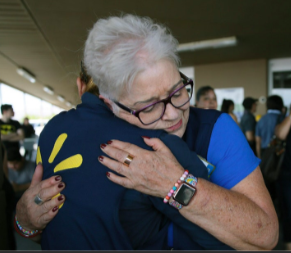Horrific, sickening, tragic. Those were the words I used to describe the news from Las Vegas two years ago — the scene of the worst mass shooting in American history. Since then, those words have come to my mind again and again: Parkland. Pittsburgh. And now Dayton and El Paso.
But none of them really capture the reality that such acts are utterly beyond comprehension. Each of these despicable acts of violence was followed by days of officials seeking a motive, but no rational motives can possibly exist. Whatever makes killers take 31 lives in less than 24 hours only makes sense in some delusional world most humans can’t come close to understanding.
After the words and the images sink in, it still doesn’t seem real. But we want to know why! Who or what can we blame? What can we do to prevent this sort of thing from ever happening again?
That’s when the hopelessness sets in. We want an easy answer, but there aren’t any. In fact, while it’s hard to admit, there probably aren’t any answers at all. It’s happened before and will happen again. Humans have done terrible and sickening and horrific things to others throughout recorded history.
This journey was partially described by statistician Leah Libresco in a Washington Post column following the Las Vegas shooting. Previously, the gun-control advocate had been involved with a project documenting the reality of gun deaths in the United States.
Her team found that 63 percent of gun deaths involved suicides. Most of these deaths involved older men. The biggest group of homicides involved young men, generally those who were involved with gang or criminal activity. On top of that, roughly 1,700 women were murdered, generally as a result of domestic abuse.
As she explored the data looking for answers, Libresco admitted, “the policies I’d lobbied for crumbled when I examined the evidence.” The more complex reality showed that passing new laws might make some people feel good, but it would not reduce gun violence. In the end, Libresco “found the most hope in more narrowly tailored interventions.” These solutions focused on the underlying causes, rather than the guns.
Unfortunately, in the aftermath of events like Dayton and El Paso, few people engage in the sort of careful analysis that Libresco offered. Instead, most of us respond in a visceral way. We can’t make sense of what happened, and we hate the fact that there’s nothing we can do to help. We want to get rid of that sickening feeling by believing that there is a silver lining to be found. Maybe, just maybe, we think, this is the time we will learn how to prevent this from ever happening again.
You can see this trend in the data. My polling found, for example, that 92 percent of Americans support modest restrictions on the ability to purchase guns such as waiting periods and background checks. However, just 38 percent believe such modest restrictions would actually reduce the number of gun-related deaths in America. Even supporters see these laws as futile gestures.
Researchers Jillian Peterson and James Densley of the Violence Project have studied every mass shooting in America since 1966. When it comes to laws to prevent shooters from buying guns, they found, “In 80 percent of school shootings, perpetrators got their weapons from family members, according to our data.” Of the remaining 20 percent, Some simply acquired them illegally — still more evidence of how difficult it will be to find a workable, pragmatic solution to the mass shooting crisis.
Like everyone else, I desperately want to find that silver lining. I never again want to experience another weekend like this past one. But, like Libresco, Peterson and Densley, I know that there are no magical cures or silver linings. It breaks my heart to tell people that the data shows their pet solution won’t solve anything, but that is the reality we must face.

